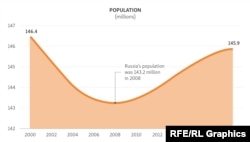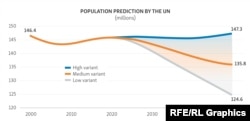Twenty years ago, on December 31, 1999, Vladimir Putin became the acting president of Russia.
Now serving his fourth term in office, Putin is dealing with a struggling economy, tough Western sanctions, unpopular government reforms, and a drop in his approval rating.
Let's take a look at how Russia was doing when Putin took charge and how it's faring today.
PEOPLE
When Russian President Vladimir Putin assumed office, Russia was losing around half a million people each year. The population started to decline after the Soviet Union collapsed in 1991. The demographic crisis hit its lowest point in 2008.
In 2013, the total number of births surpassed the total number of deaths for the first time since Putin became president.
However, this trend occurred for four subsequent years only and Russia is now dealing with a natural population decrease again.
According to CIA estimates, Russia was among 10 countries with the highest death rates per 1,000 people in 2018.
To compensate for the population decline, Russia plans to attract up to 10 million Russian-speaking migrants by 2025 by offering them citizenship.
However, the United Nations has predicted Russia might lose up to 15 percent of its population by 2050; the most pessimistic scenarios cite a 44 percent decline by 2100.
The expected lifespan of Russian men has increased by seven years over the last two decades.
However, it's still more than 10 years shorter than the lifespan of Russian women and 14 years shorter than that of Japanese men.
ECONOMY
Russia was dealing with an inflation rate of more than 85 percent after the financial crisis in 1998.
Over the next two decades, the rate has significantly decreased but financial crises in 2008 and 2014 sent the rate over 14 and 15 percent, respectively.
Russia's imports and exports grew steadily after Putin became president but experienced two significant drops: one in 2009 following the global financial crisis and the Russia-Georgia war and another one in 2015 after Russia forcibly annexed Crimea a year earlier and faced harsh economic sanctions by the West.
The share of Russia's export of mineral products has increased from 51 to 58 percent, while the export of metals has decreased from 19 to 12 percent. The export of agricultural products -- such as wheat and barley -- has been on the rise.
In 2017, Russia imported a larger share of machines, cars, and vehicle parts. On the other hand, the import of most agricultural products, such as sugar or wheat, has been on the decline.
The Russian ruble has been losing value against the U.S. dollar as a result of falling oil prices and Western economic sanctions that were imposed after the annexation of Crimea in 2014.
In 2000, Russia's reserves (including gold) were worth approximately $27 billion based on current exchange rates, comparable to the reserves of Poland or Norway at that time. In 2018, Russia had almost $460 billion -- the fifth-largest reserves in the world.
MILITARY
Russia spent almost 4 percent of its GDP on the military in 2018. That's significantly less than Saudi Arabia, which spent almost 9 percent of its GDP on the military in 2018, but more than the United States, China, or any EU country.
However, when it comes to real spending, Russia spent 10 times less on its defense than the United States in 2018.
APPROVAL
A few months after Vladimir Putin was inaugurated in 2000, he was criticized for the way he handled the Kursk submarine tragedy. His approval rating was at 64 percent.
Eight years later, Putin's approval rating exceeded 80 percent, following the five-day conflict with Georgia. However, in 2011, Russia was dealing with nationwide protests and Putin's rating fell again -- to 66 percent. The highest approval rating was recorded in 2014, after Russia forcibly annexed Crimea.
However, in 2018 Putin signed a controversial pension-reform bill and his rating fell to 66 percent, close to his lowest rating ever.
Sources: World Bank, Levada Center, The World Factbook, United Nations, OECD, Observatory Of Economic Complexity



















